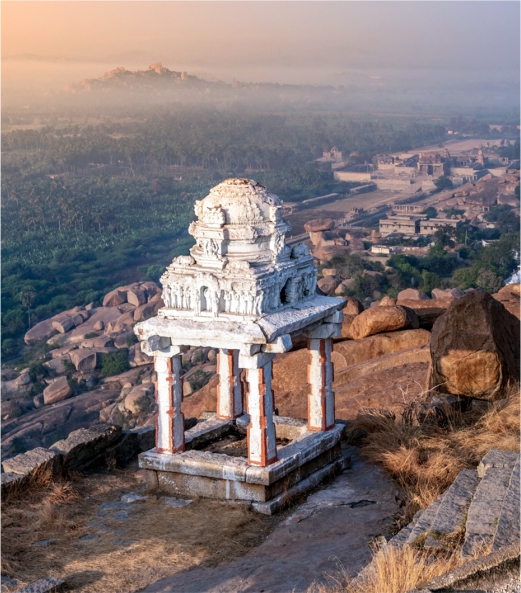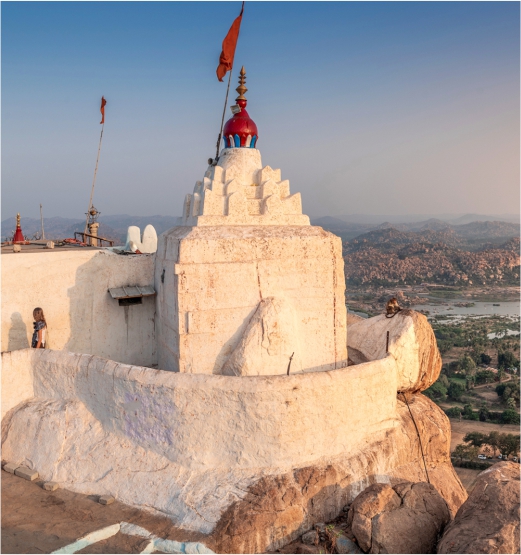Hampi, Karnataka
Been there recently?
Hampi, also called the “City of Ruins,” is a designated World Heritage Site by UNESCO. It is surrounded by 500 historic sites, stunning temples, vibrant street markets, bastions, treasury buildings, and the remains of the Vijayanagar Empire, which ruled from about 1500 to 1507 AD. A legendary lost city that was once the centre of an ancient kingdom and an auspicious temple town standing on the banks of the powerful Tungabhadra river is still evident today in the ruins of temples and other buildings. Boulders of various sizes surround Hampi, and they are simple to climb for a breathtaking view of the city. Old aqueducts, canals, military barracks, and stables are also visible. The last capital of the Vijayanagara kingdom, one of the most important in southern India, was the grand site of Hampi. In the fourteenth through sixteenth centuries, its wealthy kings erected magnificent temples and palaces that attracted the admiration of visitors. Even after being plundered later, Hampi still has more than 1,600 monuments left, including palaces, forts, memorial buildings, temples, shrines, pillared halls, baths, and gateways. Rock climbers, hikers, and other adventure sport enthusiasts are drawn to the architectural ruins because of the surreal landscape they are in, which is dotted with piles of enormous boulders balanced precariously over kilometres of undulating terrain.
Nearby Places to See
Virupaksha Temple
Hampi Bazaar is home to Virupaksha Temple, one of the region’s oldest buildings. The temple’s 49-m-tall (approximately) gopuram tower, which is dedicated to Lord Virupaksha, an incarnation of Lord Shiva, is said to have been built in 1442. A notable landmark in Hampi is the towering gopuram, which dominates the city’s skyline, as well as the stucco figures that surround the temple’s exterior. It is Hampi’s only continuously functioning temple.
Hampi Bazaar is home to Virupaksha Temple, one of the region’s oldest buildings. The temple’s 49-m-tall (approximately) gopuram tower, which is dedicated to Lord Virupaksha, an incarnation of Lord Shiva, is said to have been built in 1442. A notable landmark in Hampi is the towering gopuram, which dominates the city’s skyline, as well as the stucco figures that surround the temple’s exterior. It is Hampi’s only continuously functioning temple.


Matanga Hill
The Matanga Hill, the highest point in the area situated in the middle of Hampi, provides breathtaking views of the ruins. The Kodanda Rama Temple can be found on the northern slope of the hill, where it descends to the Tungabhadra. The Achyutaraya Temple, built in 1534, is situated on its eastern edge. The Veerabhadra Temple is located atop the hill and is accessible via numerous winding paths. The journey up usually takes 30 minutes, and the views of the rising and setting sun are simply stunning. There is a paved route that travellers can take to the peak, but those seeking a greater challenge can take the steeper and tougher trekker’s trail.
The Matanga Hill, the highest point in the area situated in the middle of Hampi, provides breathtaking views of the ruins. The Kodanda Rama Temple can be found on the northern slope of the hill, where it descends to the Tungabhadra. The Achyutaraya Temple, built in 1534, is situated on its eastern edge. The Veerabhadra Temple is located atop the hill and is accessible via numerous winding paths. The journey up usually takes 30 minutes, and the views of the rising and setting sun are simply stunning. There is a paved route that travellers can take to the peak, but those seeking a greater challenge can take the steeper and tougher trekker’s trail.
Monkey Temple
The Monkey Temple in Hampi is dedicated to Lord Hanuman. It is located on the Anjaneya Hill and is a short coracle ride from the city’s primary ruins across Tungabhadra. The temple, perched atop the hill, is accessible via a set of stairs that wind up to it. A small shrine for Lord Rama and Goddess Sita has been built inside the temple, and an image of Lord Hanuman is carved into a rock outside. The temple overlooks lush paddy fields, coconut tree plantations, and the ruins that stretch into the distance. The view from the top is breathtaking. Rugged mountains surround the entire area, and a raging river adds to its pristine beauty.
The Monkey Temple in Hampi is dedicated to Lord Hanuman. It is located on the Anjaneya Hill and is a short coracle ride from the city’s primary ruins across Tungabhadra. The temple, perched atop the hill, is accessible via a set of stairs that wind up to it. A small shrine for Lord Rama and Goddess Sita has been built inside the temple, and an image of Lord Hanuman is carved into a rock outside. The temple overlooks lush paddy fields, coconut tree plantations, and the ruins that stretch into the distance. The view from the top is breathtaking. Rugged mountains surround the entire area, and a raging river adds to its pristine beauty.


Vijaya Vittala Temple
The finest examples of Vijayanagara architecture can be found in the Vittala Temple, one of the region’s most elaborate buildings from the sixteenth century. The temple’s highlight is a spectacular stone chariot that stands in the courtyard; it is known as the “showstopper” of Hampi due to its elaborate carvings and location. It is one of the finest examples of the Vijayanagara style of architecture. The intricately carved musical pillars in this temple are a special feature; when struck with a wooden stick, they are said to sound like 81 different musical instruments.
The finest examples of Vijayanagara architecture can be found in the Vittala Temple, one of the region’s most elaborate buildings from the sixteenth century. The temple’s highlight is a spectacular stone chariot that stands in the courtyard; it is known as the “showstopper” of Hampi due to its elaborate carvings and location. It is one of the finest examples of the Vijayanagara style of architecture. The intricately carved musical pillars in this temple are a special feature; when struck with a wooden stick, they are said to sound like 81 different musical instruments.
Lotus Mahal
One of Hampi’s most well-known architectural landmarks is the Lotus Mahal. The Zenana Enclosure, within which this structure is located, was reserved for the exclusive use of the Vijayanagara royal women. The magnificent building, also referred to as Kamal Mahal or Chitragani Mahal, has a central dome that is shaped like a lotus bud. A dome that resembles an open lotus bud is also used to cover the corridors and the balcony. The multi-layered roof design is reminiscent of Indo-style buildings, while the palace’s curves reflect Islamic architectural design. The palace is a symmetrically designed, two-story building. It is enclosed by a rectangular wall and has four towers in the shape of a pyramidal lotus. Beautiful carvings of birds and sea creatures can be found on the walls and pillars.
One of Hampi’s most well-known architectural landmarks is the Lotus Mahal. The Zenana Enclosure, within which this structure is located, was reserved for the exclusive use of the Vijayanagara royal women. The magnificent building, also referred to as Kamal Mahal or Chitragani Mahal, has a central dome that is shaped like a lotus bud. A dome that resembles an open lotus bud is also used to cover the corridors and the balcony. The multi-layered roof design is reminiscent of Indo-style buildings, while the palace’s curves reflect Islamic architectural design. The palace is a symmetrically designed, two-story building. It is enclosed by a rectangular wall and has four towers in the shape of a pyramidal lotus. Beautiful carvings of birds and sea creatures can be found on the walls and pillars.


-
Destination



